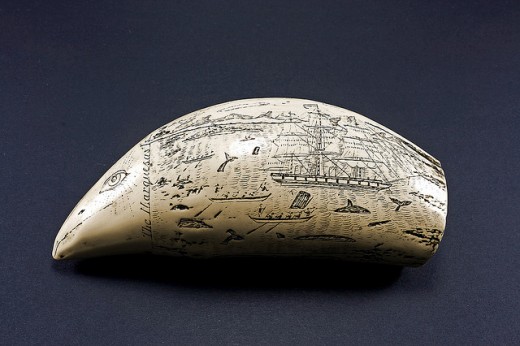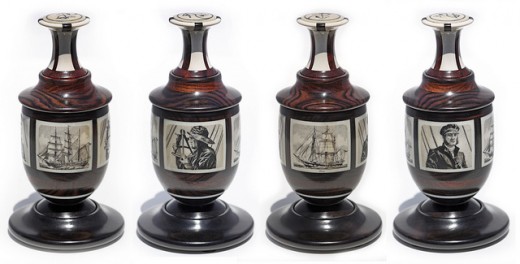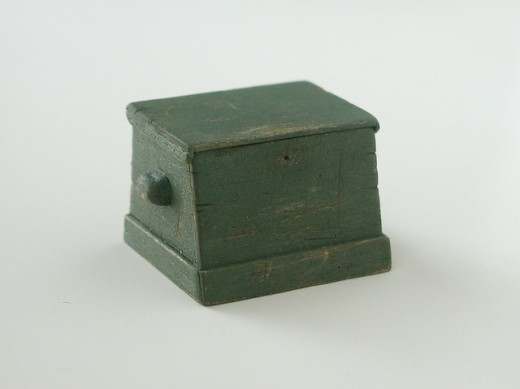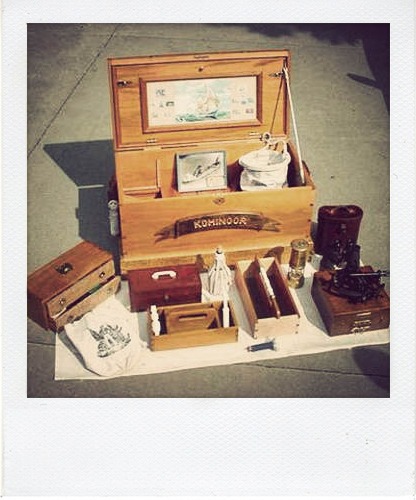The Beauty and History of The Scrimshaw

What Is Scrimshaw?
It looks like a very unusual word and in many ways it is. The origin of the word is a bit of a mystery in that we really aren't sure where it came from. It is generally accepted that the term "was probably derived from a Dutch or English nautical slang expression meaning 'to waste time.'”
A scrimshaw is a piece of whale tooth or similar material that has been etched either with a pin or other sharp object and then colored in with some sort of dye. The dye usually was in the form of black ink, however, ink may not have been available on the high seas. In those cases a sailor might use tobacco juice, vegetable dyes, or the ashes from wood burned on the ship for warmth. A sailor or person who performs this art is called a scrimshander.
The whalebone is generally the most well-known and popular scrimshaw, however, there are many other forms. These will be introduced and discussed in greater length.

The History of This Art Form
Whaling, which had its peak in the 19th century, was an endeavor that had sailors on the sea for as long as 5 years. During this time several months might elapse between whale sightings. The men would go absolutely stir crazy if they didn't find something to occupy their time. Scrimshaw was a good craft to get involved with to make time go by easier.
"The ivory teeth from the Sperm Whale were the most popular for Scrimshaw engravings because they were plentiful and small enough to be stowed away in the sailor's sea chest and since they had no commercial value, the ship's Captain would hand them out at no cost to the sailors that wanted them." - hopscrimshaw
Captains did think this practice of scratching pictures into ivory bone was a waste of time, hence its name. I imagine, though, they did not discourage their men from this trade since it kept their sanity and continued to hone their focus that would be needed once a whale was sighted.

Scrimshaw Can Be Found Everywhere
Scrimshaw is very versatile in that it can be embedded in just about anything your imagination can dream up. The photo above reveals these engravings being used in lamp bases for home décor. In my research I have found many other interesting uses:
- Hinges and latches
- Handles for umbrellas, canes, tools, and weapons
- Earrings, cuff links, pendants, and corset bucks
- Pie crimpers
- Animal figurines
- Tatting shuttles, nalbinding needles, and cocobolos
- Even on a Poker Chip
Ditty Box

A Place To Keep Things
The ditty box shown above is another example of a type of scrimshaw. It is very different than its ivory counterpart, but it too has an interesting story.
Ditty bags were the first creation of sailors to store any items they wanted to keep safe.
"It is said that in the Royal Navy they contained beeswax, varied needles, buttons of different types common on clothing of the period, pins, white tape, Dutch tape, thimble, whited brown thread, black thread, worsted blue and scraps of light duck. These items were generally carried in a small wooden box, round or square, or rolled in cloth, tied, and carried in the ditty bag along with the owner’s other personal items." - frayedknotarts.com
Inside these boxes could also be found many of a sailor's personal belongings like letters, photographs, trinkets, or anything else deeply valued that could fit inside.
Prior to the use of the box, the ditty bag was used by itself as the preferred choice. However, in 1872, Dr. Gihon of the U.S. Navy advised that the boxes be used and allowed in preference to the bag for hygiene reasons. The bag was usually made from no. 12 duck canvas, which could be whitewashed, but still ran the potential for harboring dangerous bacteria. The boxes were made of wood or baleen which nearly eliminated any possibility of disease contamination.

How Are Scrimshaw Made?
The following video created by David Adams will show you step by step how to scrimshaw an ivory piece. If you just watch the first 2 to 3 minutes of it, you'll get a good idea of how it is done.

My Grandfather's Prize Catch
After my grandfather got back from World War II and barely surviving the beaches of Normandy, he decided that he and his wife were going to buy an RV and travel all over the United States. He wanted to see this country he nearly lost his life defending.
While on the East of Florida they came across a market that specialized in selling trinkets, figurines, or any object that had a seafaring theme to it. While searching through the tables they found what appeared to be scrimshaw. Although my grandfather was an Army man, he did have some buddies in other branches of the service. Hence he was familiar with this Naval form of art.
He bought several pieces at the time and a few years ago two of them were given to me in memory of my grandpa who passed away in 2000. From what I have been told by my aunt, one is authentic scrimshaw and the other is a fake replica. The replica is a modern piece etched out with lasers and meant to try to fool the authentic collector. They are both cool pieces and are now a part of my family heirloom collection.

The Development of the Whaling Trade
Back in the 1800's whaling was a profession that most likely was an acceptable means of earning a day's pay. I can only imagine what it would be like to kill and then capture a mammal of such size and weight using only tools that we would now consider primitive.
The story of scrimshaw could not be completely told without mentioning the fact that whaling, for the most part, is illegal.
The only whale that I have found to be accepted to hunt is the Minke whale. Japan seems to have whale hunting allocations for their country that they place under the guise of scientific research. And, of course, what happens in international waters will always be a challenge for the authorities who are trying to maintain law. But, despite all of these factors, whales have become a protected species and are not permitted to be hunted for their ivory. I believe elephants have been placed in this ranking as well.
In response to protecting sea (and land) life, scrimshanders have been seeking out new mediums to preserve their craft. Today they may use any of the following:
- Naturally-shed antlers from deer, elk, or moose
- Tagua nuts
- Sea shells
- Horns, like black gunpowder hunting horns
- Hard woods like ebony

The Value of Your Scrimshaw
The most coveted from of scrimshaw is the ivory bone which is valuable for the obvious reasons. Some of these pieces can be upwards of 200 years old and will be intensely sought out by potential buyers.
The most coveted scrimshaw are the ones engraved on ivory teeth. According to Antiques and Fine Arts Magazine these pieces are valued anywhere from less than $1,000 all the way up to $75,000.
Ditty boxes generally do not hold as much value unless they are embedded with ivory scrimshaw or some other valuable material like silver or gold. For the most part ditty boxes have a greater sentimental value than they might have monetary value.
I'm Curious About Your Experience
Have you ever held a piece of scrimshaw? If so, which type was it?
Works Cited
http://www.hopscrimshaw.com/about/scrimhistory.htm
http://www.frayedknotarts.com/files/dittybagbox.html
http://www.antiquesandfineart.com/articles/article.cfm?request=177
http://www.scrimshawstudio.com/faq.html#Anchor-35326






